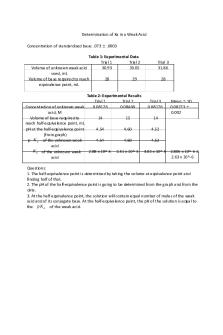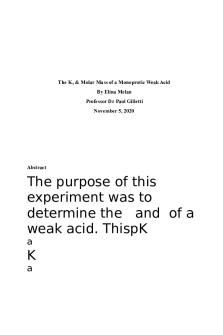Laboratory Chemistry 113 - Laboratory Det Ka: Titration Of A Weak Acid PDF

| Title | Laboratory Chemistry 113 - Laboratory Det Ka: Titration Of A Weak Acid |
|---|---|
| Course | Chemistry Laboratory I |
| Institution | University of Miami |
| Pages | 3 |
| File Size | 129.2 KB |
| File Type | |
| Total Downloads | 37 |
| Total Views | 143 |
Summary
Laboratory Report...
Description
Rachel Tammone CHM113 Section &r Heather Pedziwiatr 4/11/14 Determination of Ka: Titration of a Weak Acid Purpose: The purpose of this lab is to determine the acid dissociation constant, Ka, by using a LoggerPro and LabPro to determine the pH of the solution. Ka will be found from the pH of the original solution and from the pH of the half-neutralization point. This lab teaches students to find the equivalence point of a titration by looking at the titration curve their data produces. It is important to learn about the acid dissociation constant and titration curves because it allows students to see equilibrium depends on the relationship of the ions present in the solution being titrated. Theory: In order to perform this experiment successfully, NaOH and HC2H3O2 most be titrated very carefully so an accurate and useful curve will be produced. A pH sensor must be placed into the beaker containing the titrated solution so the curve can be obtained. When placed in the titration reagent, the NaOH mist drip out of the tip at a rate of about 1 to 2 drops per second in order to achieve a good titration curve. After the titration is complete, the equivalence point can be found on the graph. The equivalence point gives both a volume and pH value that are necessary to find [HA]. After finding [HA], Ka is found using the formulas: Ka = [H3O+] 2/[HA] and Ka = 10-pH1/2. Procedure: 1. 2. 3. 4.
Titration apparatus & drop counter will already be set up for you Obtain LoggerPro Add 20 mL of weak acid solution to a 100 mL beaker Connect the Drop Counter to DIG/SONIC 1 of the Vernier computer interface & connect the pH sensor to CH 1 of the computer interface 5. Run Logger Pro on the computer & open the file “07b Acid-Base (drop count)” 6. Check the reagent reservoir for leaks by filling it with some water. Then rinse it with a little NaOH before filling it with slightly more than 60 mL of NaOH 7. Calibrate the drop volume for the drop counter then make sure the drop rate is 1 to 2 drops per second by adjusting the top and bottom valves on the reagent reservoir 8. Place a magnetic stirring bar in the beaker containing the weak acid. Place beaker under the reagent reservoir 9. Stick the pH sensor in the weak acid, taking an initial reading then turn on the stir bar 10. Click collect data on the computer and open the TOP valve only of the reagent reservoir. Data will not be collected until the first drop falls through the drop counter and into the beaker 11. After the large jump in pH occurs, add about 7 more millimeter of NaOH solution, then click stop. Turn the bottom valve of the regent reservoir to a closed position. 12. Dispose of the beaker contents & extra reagent reservoir contents as directed 13. Clean and put away all lab equipment used 14. Analyze data appropriately
Data/Calculations:
- From this graph of the titration curve, the equivalence volume was found Equivalence Volume: 29.15 mL - Looking at the titration curve and highlighting the middle of the steep increase found the equivalence volume [HA] original = .01503 mol/L - The moles of Ha was found using the formula: mol HA = L OH- soln * (mol OH-/L soln) * (mol HA/mol OH-) o .02915 * (.1031/1) * (1/1) = .00300537 - Mol HA then had to put into units of mol per L to get the concentration o .00300537/.2 = .01503 mol/L Ka from pH of original solution: 1.9188X 10-5 - Ka was found by using the formula: Ka = [H3O+] 2/[HA] o [10-32.7] 2 / [.01503] = .000019188 Ka from pH of half-neutralization point: .02317 - Ka was found using the formula: Ka = 10-pH1/2 o 10 (-3.27)(1/2) = .02317 Discussion/Error Analysis: Error could have happened throughout this experiment when using the Lab Pro system. It tends to be inaccurate and unreliable. If the equipment was not working properly, or it was working properly but the student recorded the wrong pH, all calculations done would then be wrong. If the equivalence point/volume was not found properly, later calculations could also be wrong. Another source of error could have come from the samples and their molarities. The molarity of NaOH was given, but if for some reason it was inaccurate that could affect the results. Also, if the drops per second was too fast or too slow could lead to altered results. If the formulas to find Ka were used improperly or the wrong numbers were substituted in, the data could also be inaccurate.
Conclusion: In the lab, Ka was found for a weak acid using a pH sensor/Lab Pro software. Manual data calculations were done using the formulas mol HA = OH- soln * (mol OH-/L soln) * (mol HA/mol OH-), Ka = [H3O+] 2/[HA], and Ka = 10-pH1/2. Overall, the lab carried out its purpose in teaching how to determine Ka of a weak acid....
Similar Free PDFs

Titration of a Diprotic Acid
- 7 Pages

Acid-Base Chemistry- Ka and Kb
- 3 Pages

Laboratory Notebook
- 35 Pages
Popular Institutions
- Tinajero National High School - Annex
- Politeknik Caltex Riau
- Yokohama City University
- SGT University
- University of Al-Qadisiyah
- Divine Word College of Vigan
- Techniek College Rotterdam
- Universidade de Santiago
- Universiti Teknologi MARA Cawangan Johor Kampus Pasir Gudang
- Poltekkes Kemenkes Yogyakarta
- Baguio City National High School
- Colegio san marcos
- preparatoria uno
- Centro de Bachillerato Tecnológico Industrial y de Servicios No. 107
- Dalian Maritime University
- Quang Trung Secondary School
- Colegio Tecnológico en Informática
- Corporación Regional de Educación Superior
- Grupo CEDVA
- Dar Al Uloom University
- Centro de Estudios Preuniversitarios de la Universidad Nacional de Ingeniería
- 上智大学
- Aakash International School, Nuna Majara
- San Felipe Neri Catholic School
- Kang Chiao International School - New Taipei City
- Misamis Occidental National High School
- Institución Educativa Escuela Normal Juan Ladrilleros
- Kolehiyo ng Pantukan
- Batanes State College
- Instituto Continental
- Sekolah Menengah Kejuruan Kesehatan Kaltara (Tarakan)
- Colegio de La Inmaculada Concepcion - Cebu












